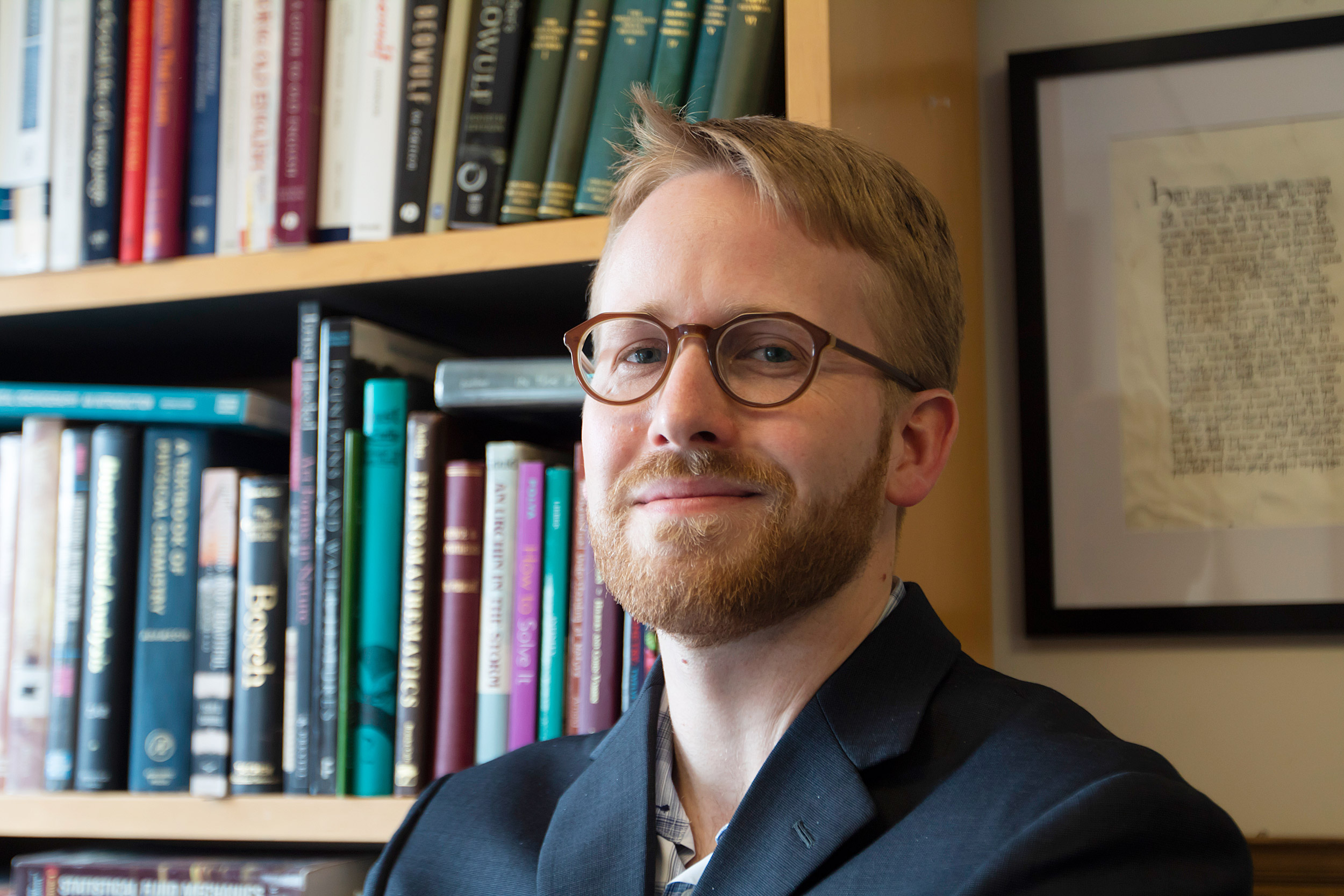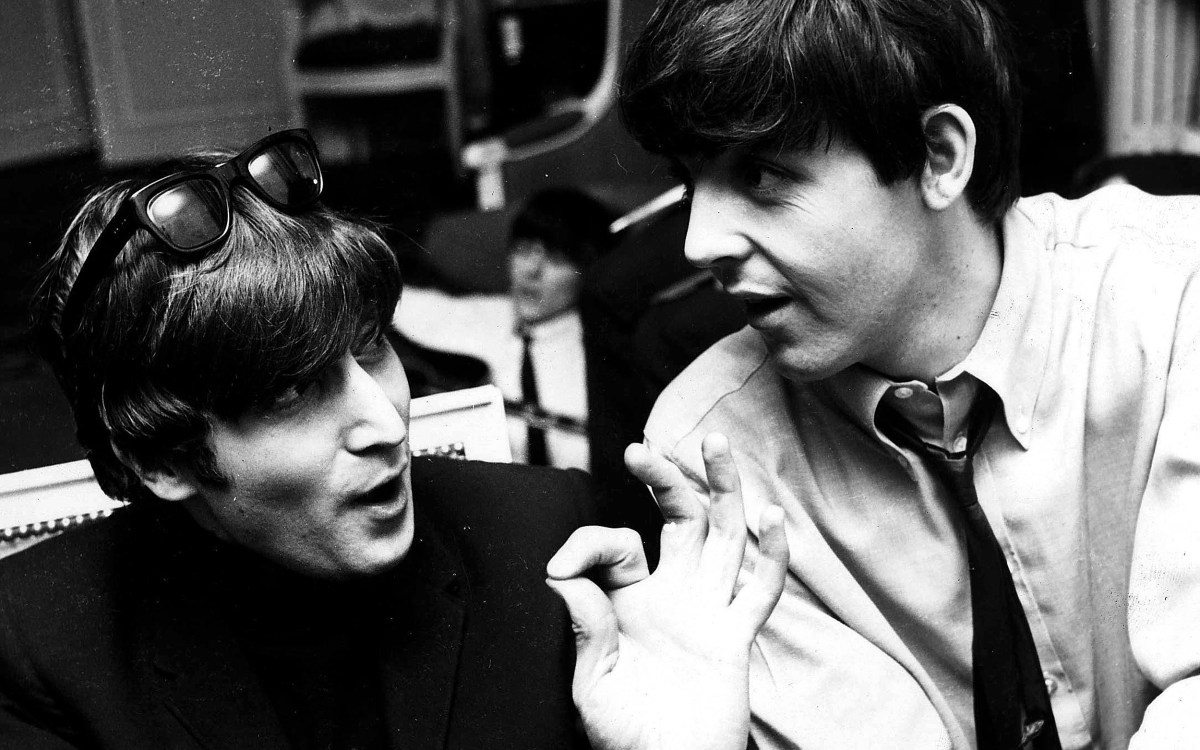
In a bid to solve one of literature’s oldest mysteries, a team of researchers led by Harvard’s Madison Krieger turned to stylometry.
Photo by María F. Sánchez
Breaking down ‘Beowulf’
Researchers use statistical technique to find evidence that Old English poem had a single author
It’s been a towering landmark in the world of English literature for nearly a millennium, but for two centuries “Beowulf” has also been the subject of fierce academic debate, much of it revolving around the question of whether the epic poem is the work of a single author or was stitched together from multiple sources.
In an effort to resolve the dispute, a team of researchers led by Madison Krieger, a postdoctoral fellow at the Program for Evolutionary Dynamics, and and Joseph Dexter, Ph.D. ’18, a Neukom Fellow at Dartmouth College, turned to a very modern tool — the computer.
Using a statistical approach known as stylometry, which analyzes everything from the poem’s meter to the number of times various combinations of letters show up in the text, Krieger and his colleagues found new evidence that “Beowulf” is the work of a single author. The study is described in an April 8 paper published in the journal Nature Human Behaviour.
In addition to Krieger and Dexter, the study was co-authored by English Professor Leonard Neidorf of Nanjing University, an expert on “Beowulf” whose numerous studies include a book on the poem’s transmission, as well as Michelle Yakubek, who worked on the project as a student at MIT’s Research Science Institute, and Pramit Chaudhuri, associate professor of classics at the University of Texas at Austin. Chaudhuri and Dexter are the co-directors of the Quantitative Criticism Lab, a multi-institutional group devoted to developing computational approaches for the study of literature and culture.
“We looked at four broad categories of items in the text,” Krieger said. “Each line has a meter, and many lines have what we call a sense pause, which is a small pause between clauses and sentences similar to the pauses we typically mark with punctuation in modern English. We also looked at aspects of word choice.
“But it turns out one of the best markers you can measure is not at the level of words, but at the level of letter combinations,” he continued. “So we counted all the times the author used the combination ‘ab,’ ‘ac,’ ‘ad,’ and so on.”
Using those metrics, Krieger said, the team combed through the “Beowulf” text, and found it to be consistent throughout — a result that supports the theory of single authorship.
“Across many of the proposed breaks in the poem, we see that these measures are homogeneous,” Krieger said. “So as far as the actual text of Beowulf is concerned, it doesn’t act as though there is supposed to be a major stylistic change at these breaks. The absence of major stylistic shifts is an argument for unity.”
The study is just the latest effort to pin down the poem’s mysterious background.
“There are two big debates about ‘Beowulf,’” Krieger explained. “The first is when it was composed, because the date of composition affects our understanding of how ‘Beowulf’ is to be interpreted. For instance, whether it is a poem near or far in time from the conversion to Christianity is an important question.”
The second debate among “Beowulf” academics, Krieger said, is the one he and his colleagues were considering.
“The first edition that was widely available to the public was published in 1815, and the unity of the work was almost immediately attacked,” Krieger said. “From high school, everyone remembers the battle with Grendel and Grendel’s mother, and maybe the dragon, but if you go back and read the whole poem, there are weird sections about, for instance, how good Beowulf is at swimming, and other sections that go back hundreds of years and talk about hero kings that have ostensibly nothing to do with the story. So the way we read it now … seems very disjointed.”
One piece of evidence that has factored into debates about unitary composition can be seen just by looking at the text.
“The handwriting is different,” Krieger said. “At what I would call a random point in the poem, just mid-sentence, and not really an important sentence, the first scribe’s handwriting stops, and somebody else takes over. It’s clear that the second scribe also proofread the first scribe, so even though currently nobody really thinks that these two guys were different poets, or were joining together parts of a poem at this random midsentence location, it has helped contribute to a narrative according to which the writing of ‘Beowulf,’ and maybe its original composition, was a long and collaborative effort.
“Arguments based on the poem’s content or its author’s supposed belief system are vital, of course, but equally important are arguments based on the nitty-gritty of stylistic details. The latter also have the merit of being testable, measurable.”
Madison Krieger
In the 19th century, the prevailing view among academics was that the poem must be the work of multiple authors. It wasn’t until the early 20th century that another author — one whose name is all but synonymous with epic storytelling — began to challenge that idea.
His name? J.R.R. Tolkien.
More like this
“Tolkien was one of the greatest champions of single authorship,” Krieger said. “He was a very prominent ‘Beowulf’ scholar, and in 1936 he wrote a landmark piece, ‘Beowulf: The Monsters and the Critics,’ that really revived the idea that it was the work of a single person.”
At the heart of Tolkien’s argument, Krieger said, is the way in which Christianity is reflected in the text.
“The Christianization of ‘Beowulf’ is very interesting, because every single character in it is a pagan, even in these odd digressions,” Krieger said. “Beowulf is from southern Sweden and goes to Denmark to help other pagan Germanic peoples fight monsters … but it’s overlaid throughout with a Christian perspective and infused with Christian language.” Computational evidence from the study supports Tolkien’s view from a new perspective. “Arguments based on the poem’s content or its author’s supposed belief system are vital, of course, but equally important are arguments based on the nitty-gritty of stylistic details. The latter also have the merit of being testable, measurable.”
Though he acknowledged it’s unlikely the new study will end the debates about the poem’s authorship, Krieger believes it can shed important new light on English literary traditions.
“If we really believe this is one coherent work by one person, what does it mean that it has these strange asides?” he asked. “Maybe one of the biggest takeaways from this is about how you structured a story back then. Maybe we have just lost the ability to read literature in the way people at the time would have understood it, and we should try to understand how these asides actually fit into the story.”
Going forward, Krieger and his colleagues are hoping to apply the stylometry tools developed for the study to other literary traditions and other landmark works.
“Even works as well-studied as ‘The Iliad’ and ‘The Odyssey’ have yet to be analyzed using a full array of computational tools,” Krieger said. “The fine-grained features that seem to matter most have never been examined in a lot of traditions, and we’re hoping to spread these techniques that we think could change the way similar problems are approached.”
Krieger also hopes to use the techniques to understand the stylistic evolution of English across history.
“Putting Old English in context is the springboard,” he said. “This is the birth of English literature. From here we can look at what aspects of style evolved — not just grammar, but at the cultural level, what features people enjoyed, and how they changed over time.”
Aside from their ability to shed new light on works of literature, Krieger suggested the stylometry tools used in the study might also have some thoroughly modern uses — including spotting troll farms and fake news online.
“In retrospect, we know many thousands posts on Facebook were written by the same Macedonian troll farm during the 2016 election,” he said. “If we had some way to identify that posts were likely written by the same author, that would obviously be very useful in deterring misinformation campaigns.”
Ultimately, though, Krieger believes the study is a prime example of how ancient texts still hold secrets that can be uncovered through the use of modern tools.
“This is the first step in taking an old debate and refreshing it with some new methodology,” he said. “It’s a new extension of the whole critical apparatus, and it’s exciting that an area probably assumed to be very traditional can in fact be at the cutting edge of work that spans the humanities and sciences.”
This research was supported with funding from a Neukom Institute for Computational Science CompX Grant, a National Endowment for the Humanities Digital Humanities Start-Up Grant, a New Directions Fellowship from the Andrew W. Mellon Foundation, a National Science Foundation Graduate Research Fellowship, and a Neukom Fellowship.








